NavSource Online: Aircraft Carrier Photo Archive
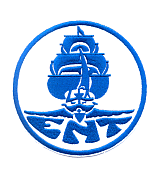
Contributed by Scott Dyben.
Official U.S. Navy Photograph, now in the collections of the U.S. National Archives (photo # 80-G-463357)
Please report any broken links or trouble you might come across to the Webmaster. Please take a moment to let us know so that we can correct any problems and make your visit as enjoyable and as informative as possible.

| Click On Image
For Full Size Image |
Size | Image Description | Contributed
By And/Or Copyright |
|
|---|---|---|---|---|
| World War II |
||||
 NS0206ao |
143k | "Th[is] famous photo, [...], shows the crash site of a US Navy SBD with two crew members and also the crash of a Japanese Aichi Val dive bomber with two crew members. The two planes crashed next to each other because they were tightly engaged and one apparently struck the other, with no altitude to bail out, killing all four in both planes." "The US Navy air crew were recovered later, however an Army patrol buried the badly burned Japanese air crew in an unmarked grave near the crash site and the location was lost due to the rough coral terrain. They are still there—PO2c Koreyoshi Sotoyama, pilot and radioman, Flyer 1c Hajime Murao." LTCOL Claude A. Larkin, USMC, CO, MAG-21, later testified: "We saw one of these Enterprise airplanes and one Japanese airplane collide in the air. Both of them fell and burned a half mile south and east of Ewa." [ENS John H.L.] Vogt's SBD-2 [(6-S-3, BuNo 2160)] crashed near the intersection of Belt Road and Ewa Beach Road; neither Vogt nor Sid[ney] Pierce[, RM3c,] had gotten out. (Quoted from Steady Nerves and Stout Hearts, by Robert J. Cressman & J. Michael Wenger.) "The crash site itself was also lost as decades later a golf course was constructed on the property after presumably all of the visible crash wreckage had been removed by the military." "Using documents, maps, air photos, etc obtained from National Archives, I have been able to locate the crash area again as seen in the photo, which is near to the main golf country club building. In 1941 the area was a thick forest of Kiawe trees." "This action was the largest air battle of the Pearl Harbor attack which actually took place over what is today known as Ewa, Oahu, near One'ula Beach. Army P-40B Warhawks shot down Japanese Aichi Vals while Japanese Zero's engaged several US Navy SBD's over the shoreline and what is today a golf course. Amazingly, one of the most famous photos of this air battle and resulting crashes was captured by an Army photographer in a passing B-17 attempting to land at Hickam Field." "We believe that there should be a monument-marker placed there that describes this historic December 7, 1941 air battle and the names of the American and Japanese killed there in the crashes. I believe funds could be raised from US Veteran groups and in Japan for this marker-monument, with coordination by the US National Park Service." "I know that people in Japan that I have been in contact with would also appreciate that Japanese pilots killed there that morning would also be remembered, which we hope will happen soon." |
John Bond, Ewa Battlefield Historian |
|
 NS0206ca |
33k | USS Enterprise (CV-6) leaving Pearl Harbor on the morning of 9 December 1941. Painting by Julien Lepelletier, posted to the "Carriers!" facebook page by Task Force Admiral. |
Via Gordon Buttars | |
 NS0206bg |
467k | USS Enterprise (CV-6) departing Pearl Harbor, 1941–42 (probably early 1942). The wartime censor has removed the radar antennas. National Archives and Records Administration (NARA) photo, # 80-G-217729. |
Mahlon Miller, Facebook Carriers! Group, via Gordon Buttars | |
 NS0206bga |
188k | Copy of the photo above, autographed by ADM Arleigh Burke. Admiral Burke was assigned to First Carrier Task Force Pacific, March 1944–May 1945. Naval History & Heritage Command photo, # NH 124511. |
Gerd Matthes, Germany | |
NS020677 |
50k | USS Enterprise (CV-6) underway circa 1942, location unknown. |
Robert Hurst | |
 NS0206cf |
898k | A U.S. Navy Douglas SBD-2 Dauntless of Bombing Squadron (VB) 6 launches from the aircraft carrier USS Enterprise (CV-6) for a raid against Marcus Island, 1 February 1942. National Naval Aviation Museum photo, # 1996.253.623. |
John Spivey | |
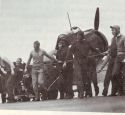 NS0206bc |
125k | This Douglas SBD Dauntless had its tail sheared off by the wing of a Japanese Mitsubishi G4M Betty bomber that had been damaged by defending Wildcat fighters. The bomber then turned and dived on USS Enterprise (CV-6). A sailor, Bruno Gaido, Aviation Machinist's Mate 2/Class, jumped into the rear seat of the parked Dauntless, swung the plane's twin machine guns towards the incoming Betty and fired. The plane came on, its wing slicing off the tail of Gaido's plane, three feet from where he sat, struck the edge of the flight deck, and tumbled harmlessly into the sea. This action took place in early February 1942, after aircraft from Enterprise, operating as part of VADM Halsey's Task Force Eight, attacked Wotje, Maloelap, and Kwajalein atolls. U.S. Navy photo. Admiral Halsey saw this battle between the man and the Japanese plane and, after it was over, promoted Gaido on the spot to 1st class. (From The Big E: The Story of the USS Enterprise, by Commander Edward P. Stafford, USN. Thanks to Bob Koch, FTG2, who pointed this out.) |
Robert Hurst | |
 NS0206as |
228k | Enterprise's first damage of the war. On 1 February 1942 (local time, 31 January in CONUS), she and her air group attacked Japanese installations on the Marshall Islands, one of the first American offensives of the war. In response, five land-based Japanese Army Nell bombers counterattacked with bombs, one landing close enough to rupture a gasoline line and start a fire that caused the damage in this photo and wounded one sailor. Four of the bombers escaped the anti-aircraft fire of the still inexperienced gunners but one circled around for a second run and nearly hit the ship before crashing into the ocean—slicing off an SBD Dauntless' tail with a wing tip as it passed over the deck on its flight to a watery grave. National Archives photo (# 80-G-271195). |
Tracy White, Researcher @ Large | |
 NS0206aaa |
230k | A deck park of SBD Dauntless aircraft aboard the carrier USS Enterprise (CV-6) on 4 March 1942, en route to raid Marcus Island. Note the individual aircraft numbers on both wings and old-style "red meatball" in the centre of the white star national markings on the wing, still carried at this date. Photo National Archives, College Park, Maryland. Photo and text from Midway: Dauntless Victory, by Peter C. Smith. |
Robert Hurst | |
 NS0206aa |
230k | Crewmen aboard the USS Enterprise (CV-6) rearming F4F-3 Wildcats after the strike against Marcus Island on 4 March 1942. Note the over-size stars then in vogue after the Pearl Harbor attack for easy recognition. Photo U.S. Navy. Photo and text from "Aircraft Carriers," by Norman Polmar. |
Robert Hurst | |
 NS0206bq |
164k | 20-mm guns being installed on USS Enterprise (CV-6) at Pearl Harbor Navy Yard, 19 March 1942. USS Fanning (DD-385) and USS Gridley (DD-380) are moored nearby. |
Brian James, via Gordon Buttars |
|
 NS020643 |
497k | USS Enterprise (CV-6) tied up at Ford Island, Pearl Harbor, second half of March–early April 1942. This photo is usually captioned as having been taken in May 1942, but the cage mast in the background contradicts such statement. "The foremast of the battleship [...] aft of the USS Enterprise [...] is that of the USS California (BB-44). USS California was berthed (and sunk) at 'F-3' during Pearl Harbor Attack, which is located directly aft of the Carrier Berth at 'F-1' ('F-1' was empty during the attack as both USS Lexington and USS Enterprise were at sea delivering aircraft to Midway and Wake Islands, respectively. USS Saratoga was returning from overhaul at Puget Sound Naval Shipyard and pulled into NAS North Island, San Diego, within hours of the attack at Pearl Harbor)." "As the photo shows the battleship 'up' in the water with her list from sinking/settling corrected, the photo had to be taken after the 15 March 1942 de-watering of the battleship. HOWEVER, USS California was done refloating and maneuvered into Pearl Harbor Navy Yard Dry Dock Number TWO on April 9, 1942 [...]. So, she couldn't have been after of the USS Enterprise at F-3 in May of 1942!" "Therefore, this photo had to be taken between 15 March and 8 April, 1942—not May 1942." (Thanks to CAPT Dan DeCosta, USNR (Ret.) for his comments.) National Archives and Records Administration (NARA) photo, NARA Identifier 266694807, Local Identifier 19-LCM-CV6-29695. |
Steve Whitby | |
 NS020643a |
132k | USS Enterprise (CV-6) tied up at Ford Island, Pearl Harbor. Like the photo above, this one is usually dated late May 1942. |
Ron Reeves | |
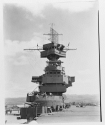 NS020694 |
195k | Details of USS Enterprise's island, taken circa March 1942 at Pearl Harbor. This shows the masthead CXAM-1 radar antenna; in the foreground are the two 1.1in (28mm.) quad AA mounts. National Archives and Records Administration (NARA) photo, # 19-N-29691. |
NARA, via Robert Hurst |
|
 NS020644 |
253k | Enterprise tied up at Ford Island, Pearl Harbor, circa March 1942. Details of the island, showing the large stack, searchlights, two cranes and numerous 20mm machine guns. National Archives and Records Administration (NARA) photo, # 19-N-29696. |
Steve Whitby | |
 NS020645 |
78k | Another view of USS Enterprise (CV-6) at Pearl Harbor, possibly taken circa March 1942. |
Steve Whitby | |
| Doolittle Raid on Japan, April 1942 |
||||
 NS0538404 |
125k | USS Dunlap (DD-384) cuts close across the stern of USS Enterprise (CV-6) while operating at sea in the Hawaiian area, 8 April 1942, the day that Enterprise departed to take part in the Doolittle raid on Japan. SBD scout bombers of Bombing Squadron Six (VB-6) are being spotted aft on the carrier's flight deck. Official U.S. Navy photograph, now in the collections of the U.S. National Archives (# 80-G-16958). |
Joe Radigan | |
 NS020657 |
111k | The aft end of Enterprise's island showing the base of her aircraft crane and both 1.1" antiaircraft gun mounts doing some target practice while escorting Hornet (CV-8) in route to launch Doolittle's B-25's. April 15th, 1942. |
Steve Whitby | |
 NS0206ce |
19k | An early SBD Dauntless is pushed onto an outrigger for storage aboard USS Enterprise (CV-6), 17 April 1942. The outrigger was a trough for an aircraft's tailwheel that allowed it to be parked topside without taking up precious deck space. At this time Enterprise was escorting USS Hornet (CV-8), which was carrying Doolittle's raiders on the approach to Japan. Photo from Air War over the Pacific, by Robert C.Stern |
Robert Hurst | |
 NS0206bo |
262k | Douglas SBD-2/-3 Dauntless dive bombers and a single Grumman F4F-4 Wildcat fighter on the flight deck of USS Enterprise (CV-6). The Big E and USS Hornet (CV-8, background) sped towards Japan's Home Islands to launch the Doolittle Raid on 18 April 1942. |
Courtesy of USS Enterprise CV-6, William T.
Barr Collection, via Bob Canchola, BT,USN (Ret.) |
|
 NS0206boa |
60k | A U.S. Navy Douglas SBD Dauntless makes a slow and low pass over the aircraft carrier USS Enterprise (CV-6) to drop a weighted message (in a "bean bag") during the Doolittle Raid, 18 April 1942. U.S. Navy photo. |
Robert Hurst | |
 NS0206bob |
427k | U.S. Navy Douglas SBD-2/3 Dauntless dive bombers of the Enterprise Air Group pictured warming up their engines on the after part of the Big E's flight deck while escorting USS Hornet (CV-8) and the Doolittle Raiders for the Tokyo Raid, April 1942. A Grumman F4F-4 Wildcat is being armed on the right. National Naval Aviation Museum photo, # 1996.253.630. |
Robert Hurst | |
 NS0206boc |
37k | U.S. Navy Douglas SBD-2/3 Dauntless dive bombers aboard USS Enterprise (CV-6), 18 April 1942. In the background the carrier USS Hornet (CV-8) speeds towards Japan's Home Islands to launch the Doolittle Raid. Photographed by William T. Barr, Photographer's Mate, USN. |
Robert Hurst | |
 NS020698 |
142k | Douglas TBD-1 Devastator torpedo plane, of Torpedo Squadron Six (VT-6), approaches USS Enterprise (CV-6) to land, 4 May 1942. Note Landing Signal Officer at left. Official U.S. Navy Photograph, now in the collections of the National Archives (#80-G-17525). |
Gerd Matthes, Germany | |
 NS028101c |
148k | ADM Chester W. Nimitz, USN, Commander-in-Chief, Pacific Fleet, pins the Navy Cross on SC2/c Doris Miller aboard USS Enterprise (CV-6) at Pearl Harbor, TH, 27 May 1942. Other awards and commendation letters were also given by the admiral. Naval History & Heritage Command (NH&HC) photo, # NH 62656. |
Bob Canchola, BT, USN (Ret.) | |
 NS0206ai |
79k | Lieutenant Commander Eugene E. Lindsey's Douglas TBD-1 Devastator torpedo-bomber (Bureau # 0370) sinking astern of the carrier USS Enterprise (CV-6) after a deck landing accident on 28 May 1942. Plane guard destroyer, USS Monaghan (DD-354) is in the left background. Enterprise was then en route to the Midway area. LCDR Lindsey, Commanding Officer of Torpedo Squadron Six (VT-6), was flying out with the rest of the air group to join the ship when the crash took place. He, and the other members of the plane's crew, were rescued by Monaghan. Official U.S. Navy Photograph, now in the collections of the National Archives (#80-G-7744). |
Naval History & Heritage Command | |
 NS0535408 |
151k | Lieutenant Commander Eugene E. Lindsey, USN, Commanding Officer of Torpedo Squadron Six (VT-6) is assisted into a breeches buoy for transfer from USS Monaghan (DD-354) to USS Enterprise (CV-6) on 31 May 1942, while the ships were en route to the Midway area. Lindsey had been picked up by the destroyer on 28 May, after his TBD-1 Devastator torpedo-bomber had crashed attempting to land on the carrier. Aviation Radioman First Class Charles T. Granat is partially visible behind Lindsey, waiting his turn on the "high line." The other member of the plane's crew, Chief Aviation Pilot Thomas E. Schaeffer is standing with hands in pockets, just to left of the transfer group. Lindsey and Granat were killed in action attacking the Japanese fleet on 4 June 1942. Official U.S. Navy Photograph, now in the collections of the National Archives (#80-G-7748). |
Joe Radigan | |
| Battle of Midway, June 1942 |
||||
 NS020622 |
109k | USS Enterprise (CV-6) entering Pearl Harbor on 26 May 1942, following the Battle of Coral Sea and shortly before the Battle of Midway. Official U.S. Navy Photograph, now in the collections of the U.S. National Archives (photo # 80-G-66121). |
Scott Dyben | |
 NS020606 |
71k | One of the rare photos of the Enterprise taken during the Battle of Midway. |
USN | |
 NS020619 |
67k | USS Enterprise (CV-6) steaming at high speed at about 0725 hrs, 4 June 1942, seen from USS Pensacola (CA-24). The carrier has launched Scouting Squadron Six (VS-6) and Bombing Squadron Six (VB-6) and is striking unlaunched SBD aircraft below in preparation for respotting the flight deck with torpedo planes and escorting fighters. USS Northampton (CA-26) is in the right distance, with SBDs orbiting overhead, awaiting the launch of the rest of the attack group. Three hours later, VS-6 and VB-6 fatally bombed the Japanese carriers Akagi and Kaga. Official U.S. Navy Photograph, now in the collections of the U.S. National Archives (photo # 80-G-32225). |
Scott Dyben | |
 NS020623 |
180k | Torpedo Squadron Six (VT-6) TBD-1 aircraft are prepared for launching on USS Enterprise (CV-6) at about 0730-0740 hrs, 4 June 1942. Eleven of the fourteen TBDs launched from Enterprise are visible. Three more TBDs and ten F4F fighters must still be pushed into position before launching can begin. The TBD in the left front is Number Two (Bureau # 1512), flown by Ensign Severin L. Rombach and Aviation Radioman 2nd Class W.F. Glenn. Along with eight other VT-6 aircraft, this plane and its crew were lost attacking Japanese aircraft carriers somewhat more than two hours later. USS Pensacola (CA-24) is in the right distance and a destroyer is in plane guard position at left. Official U.S. Navy Photograph, now in the collections of the U.S. National Archives (photo # 80-G-41686). |
Scott Dyben Ron Reeves |
|
NS020662 |
47k | "A squadron of Douglas Devastator torpedo bombers aboard the mighty Enterprise unfold their wings for the next take-off. In company with Battleship X, the Enterprise shows the Japs her power. Result: 30 by anti-aircraft and 33 by her planes." From Our Navy magazine, mid-September 1943 issue. |
Chester O. Morris | |
 NS020564 |
131k | Aviation Ordnanceman Second Class Clifton R. Bassett, of Yorktown's Bombing Squadron Three (VB-3), is carried from the flight deck of USS Enterprise (CV-6), 4 June 1942. He had been wounded by Japanese aircraft while VB-3 was attacking Hiryu. Bassett was radioman/gunner of the SBD Dauntless scout-bomber flown by Ensign Bunyan R. Cooner, USNR, seen here at top center wearing an inflatable life jacket. Photographed looking forward from the carrier's island. Note flight deck details, including wooden decking, metal tie-down strips, palisade and flight deck distance markings. Aircraft wheel chocks are piled at the right. Official U.S. Navy Photograph, now in the collections of the National Archives (photo # 80-G-7745). |
NH&HC | |
 NS020564a |
154k | Aviation Ordnanceman Second Class Clifton R. Bassett, of Yorktown's Bombing Squadron Three (VB-3), is carried from the flight deck of USS Enterprise (CV-6), 4 June 1942. He had been wounded by Japanese aircraft while VB-3 was attacking Hiryu. Bassett was radioman/gunner of the SBD Dauntless scout-bomber flown by Ensign Bunyan R. Cooner, USNR, seen here walking to the right of the stretcher party. Photographed looking forward from the carrier's island. Note flight deck distance markings and aircraft tie-down strips. Official U.S. Navy Photograph, now in the collections of the National Archives (photo # 80-G-7746). |
||
 NS020551 |
74.8Mb | "The Battle of Midway," directed by John Ford and narrated by Henry Fonda, is comprised mostly of authentic footage from the battle. This documentary, produced in 1942, won an Academy Motion Picture Arts and Sciences Award (Oscar). Then Commander (later Rear Admiral) John Ford, USNR, in civil life wrote, directed or produced more than 130 films in a career spanning four decades. Format: MP4 (.mp4) Duration: 18' 7" Size: 320 x 240 Download a free MP4 player. Another collection of footage taken by John Ford is available at Live Leak. |
Courtesy of Internet Archive. Thanks to Ron Reeves for the clue. | |
 NS0206aj |
83k | CITATION "The President of the United States takes pleasure in presenting the Navy Cross to Norman Jack Kleiss, Lieutenant, Junior Grade, U.S. Navy, for extraordinary heroism in operations against the enemy while serving as Pilot of a carrier-based Navy Scouting Plane of Scouting Squadron SIX (VS-6), embarked from the U.S.S. ENTERPRISE (CV-6), during the 'Air Battle of Midway,' against enemy Japanese forces on 4–6 June 1942. Participating in a devastating assault against a Japanese invasion fleet, Lieutenant, Junior Grade, Kleiss, with fortitude and resolute devotion to duty, pressed home his attacks in the face of a formidable barrage of anti-aircraft fire and fierce fighter opposition. His gallant perseverance and utter disregard for his own personal safety were important contributing factors to the success achieved by our forces and were in keeping with the highest traditions of the United States Naval Service." Bureau of Naval Personnel Information Bulletin No. 309 (December 1942). |
Bill Gonyo | |
| Guadalcanal Invasion; Battle of the Eastern Solomons, August 1942 |
||||
 NS0206al |
232k | Photo of the first crash landing by one of the new Grumman torpedo bombers (TBF's) aboard the USS Enterprise (CV-6). It occurred July 23, 1942, when T-8, piloted by ENS R.J. Be, slid into catwalk on the port side of the flight deck aft of the island structure. The crash occurred while the Task Force was enroute to the Solomon Islands. Official US Navy photo. |
Robert M. Cieri | |
 NS020639 |
93k | Ordnancemen of Scouting Squadron Six (VS-6) load a 500 pound demolition bomb on an SBD scout bomber on the flight deck of USS Enterprise (CV-6), during the first day of strikes on Guadalcanal and Tulagi, 7 August 1942. Note aircraft's landing gear and bomb crutch; also bomb cart and hoist. Official U.S. Navy Photograph, now in the collections of the U.S. National Archives (photo # 80-G-10458). (Note that the date printed on the photo is incorrect). |
NHC | |
 NS020633 |
149k | A Japanese bomb exploding on the flight deck of USS Enterprise (CV-6), just aft of the island, on 24 August 1942. Note: According to the original photo caption, this explosion killed the photographer, Photographer's Mate 3rd Class Robert F. Read. However, Morison's "History of U.S. Naval Operations in World War II" (volume 5, page 97) states that Read was killed by the bomb that had earlier hit the after starboard 5"/38 gun gallery, which can be seen burning in the upper left. Morison further states that the bomb seen here exploded with a low order detonation, inflicting only minor damage. Official U.S. Navy Photograph, now in the collections of the U.S. National Archives (photo # 80-G-17489). |
NHC | |
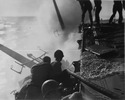 NS020633a |
84k | Fighting fires in the ship's starboard after 5"/38 gun gallery, after it was hit by a Japanese bomb during the Battle of the Eastern Solomons, 24 August 1942. Note firefighting foam on deck and displaced waterway covers. Collection of Admiral Thomas C. Kinkaid, USN. U.S. Naval History and Heritage Command photograph (# NH 102095). |
Gerd Matthes, Germany | |
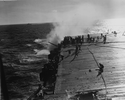 NS020633b |
113k | Crewmen fighting fires in the ship's starboard after 5"/38 gun gallery, after it was hit by a Japanese bomb during the Battle of the Eastern Solomons, 24 August 1942. Note hole in the flight deck at the bottom of the photo, the result of another bomb hit. Collection of Admiral Thomas C. Kinkaid, USN. U.S. Naval History and Heritage Command photograph (# NH 102096). |
Gerd Matthes, Germany | |
 NS020620 |
58k | A Japanese Type 99 carrier bomber (a type later code-named "Val") burns as it is shot down directly over USS Enterprise (CV-6). Note radar antenna atop the carrier's foremast, and anti-aircraft shell bursts overhead. Official U.S. Navy Photograph, now in the collections of the U.S. National Archives (photo # 80-G-31349). |
Scott Dyben | |
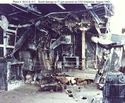 NS0206apb |
160k | View of the damage to the starboard quarter 5"/38 gun gallery aboard USS Enterprise (CV-6), resulting from a bomb that hit nearby during the battle of the Eastern Solomons, 24 August 1942. Photographed a few days later, after the ship had returned to port. Official U.S. Navy Photograph, now in the collections of the National Archives and Records Administration (# 80-G-K-411). |
Gerd Matthes, Germany | |
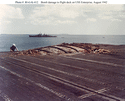 NS0206apc |
95k | Bulged flight deck structure aboard USS Enteprise (CV-6), resulting from a bomb that exploded below during the 24 August 1942 Battle of the Eastern Solomons. Photographed a few days later, after the ship had returned to port. Note the Atlanta (CL-51) class light cruiser in the background. Official U.S. Navy Photograph, now in the collections of the National Archives and Records Administration (# 80-G-K-412). |
||
 NS0206apd |
113k | Flight deck damage aboard USS Enterprise (CV-6), caused by a bomb explosion during the 24 August 1942 Battle of the Eastern Solomons. Photographed a few days later, after the ship had returned to port. Official U.S. Navy Photograph, now in the collections of the National Archives and Records Administration (# 80-G-K-413). |
||
 NS0206ap |
144k | Damage in the ship's after starboard 5"/38 gun gallery, received when a Japanese bomb hit there during the Battle of the Eastern Solomons on 24 August 1942. Photographed at the Pearl Harbor Navy Yard on 10 September 1942. Courtesy of the Naval Historical Foundation, Forrestal Collection, 1975 (# NH 83991). |
||
 NS0206apa |
106k | Near-miss bomb damage to the ship's port quarter, received during the Battle of the Eastern Solomons on 24 August 1942. Note degaussing cables torn from their mountings, just below the deck edge, and the dished-in hull plating at and below the waterline. Photographed in drydock at the Pearl Harbor Navy Yard on 10 September 1942. Courtesy of the Naval Historical Foundation, Forrestal Collection, 1975 (# NH 83992). |
||
 NS0206bf |
798k | USS Enterprise (CV-6) on her way back to Pearl Harbor for repairs after the battle of the Eastern Solomons. Note the damage to the hull, gun platform, and buckled flight deck. |
Bill Jensen, Facebook Carriers! Group, via Gordon Buttars Ron Reeves |
|
| Battle of the Santa Cruz Islands, October 1942 |
||||
 NS020607 |
122k | Photo taken on October 26, 1942 shows Enterprise smoking from her second bomb hit of the day while twisting and turning to avoid more Japanese bombs. |
USN | |
 NS020607a |
114k | A TBF-1 Avenger from Torpedo Squadron (VT) 10 prepares for launch from the aircraft carrier USS Enterprise (CV-6) during the Battle of the Santa Cruz Islands, 26 October 1942. The sign visible beyond the plane's landing gear (right) reads "PROCEED WITHOUT HORNET," indicating that USS Hornet (CV-8) was heavily damaged and the Big E's strike was not to wait to join up with Hornet's aircraft. The sign to the left reads "JAP 'CV' SPEED 25 AT 0830," indicating the last known speed of the Japanese carrier the Avenger was assigned to attack. National Naval Aviation Museum photo # 1996.488.005.001. |
Robert Hurst | |
 NS020607b |
30k | Aircraft of Carrier Air Group (CVG) 10, many critically low on fuel, circle to recover aboard USS Enterprise (CV-6) during a lull in the Battle of the Santa Cruz Islands, 26 October 1942. |
Robert Hurst | |
 NS0206ac |
33k | USS Enterprise (CV-6) during the Battle of Santa Cruz. Official U.S. Navy photo. (Thanks to Gordon Bjorklund, who identified the photo.) |
Steve Singlar ETCS USNR-ret. |
|
 NS020610 |
74k | As seen from USS South Dakota (BB-57), Enterprise is the prime target of Japanese pilots. |
USN | |
NS020611 |
105k | A "Val" dive bomber goes down in flames as the Enterprise is near-missed. | USN | |
 NS020634 |
128k | U.S. Navy ships firing at attacking Japanese carrier aircraft during the battle, 26 October 1942. USS Enterprise (CV-6) is at left, with at least two enemy planes visible overhead. In the right center is USS South Dakota (BB-57), firing her starboard 5"/38 secondary battery, as marked by the bright flash amidships. Official U.S. Navy Photograph, now in the collections of the National Archives (photo # 80-G-20989). |
NHC | |
 NS020635 |
103k | A Japanese bomb explodes off the port side of USS Enterprise (CV-6) during the action, 26 October 1942. Official U.S. Navy Photograph, now in the collections of the National Archives (photo # 80-G-30198). |
NHC | |
 NS020635a |
2.55M | During the Battle of the Santa Cruz Islands, LT Stanley Winfield "Swede" Vejtasa was credited with downing seven Japanese aircraft in one mission, becoming an "ace in a day." |
Ron Reeves | |
 NS0206cb |
470k | USS Enterprise (CV-6) anchored at Nouméa, New Caledonia, receiving signals from sailors, 8 November 1942. |
Peter Brown, via Gordon Buttars |
|
NS020678 |
59k | USS Enterprise (CV-6) at Noumea, New Caledonia, 10 November 1942, while the Big E was undergoing repairs after the Battle of Santa Cruz. The following day she recovered her air group and departed Noumea to take part in the Naval Battle of Guadalcanal (12–15 November 1942), the final major Japanese attempt to reinforce their garrison on the contested island. |
Robert Hurst | |
 NS020678a |
90k | |||
 NS0206br |
900k | A U.S. Navy Douglas SBD-3 Dauntless flies over the aircraft carriers USS Enterprise (CV-6), foreground, and USS Saratoga (CV-3) near Guadalcanal on 19 December 1942. The aircraft is likely on anti-submarine patrol. Saratoga is trailed by her plane guard destroyer. Another flight of three aircraft is visible near Saratoga. The radar array on Enterprise has been obscured by a wartime censor. National Naval Aviation Museum photo, # 1996.253.671. |
Via Bob Canchola, BT, USN (Ret.) | |
 NS020693 |
252k | The Presidential Unit Citation presented to the USS Enterprise (CV-6). |
Charles F. Hansen, son of Harold F. Hansen, QM2c, U.S. Navy | |
| 1943 |
||||
 NS020690 |
204k | With the VF-10 banner draped as a backdrop, the "Grim Reapers" pose at the end of their first war cruise, October 1942–February 1943, aboard USS Enterprise (CV-6). Note 43 "kill" markings. Second from left (middle row, NS020690) and third from left (front row, NS020690a) is then LT(JG) Roy Marlin "Butch" Voris, a Navy fighter "ace" during WW2 and who was selected in 1946 to form, develop, train and lead the Navy Flight Exhibition Team (shortly to be named the "Blue Angels"). |
Courtesy of Hank Nothhaft, "First Blue Angel" (son-in-law of CAPT Roy M. "Butch" Voris) | |
 NS020690a |
211k | |||
 NS0206ba |
82k | "Enterprise in Pearl Harbor passing Fort Kamehameha. From the looks of her configuration, I would say this was taken sometime from May to July of 1943, after returning from the South Pacific and going to Puget Sound for refit. There was no credit with the picture." |
Courtesy of the facebook group CARRIERS! via Gordon Buttars | |
 NS020636 |
87k | F6F Hellcat fighters taxiing forward on the flight deck, during training exercises, 2 July 1943. Another F6F is in flight overhead, with its landing gear and tail hook extended. Official U.S. Navy Photograph, now in the collections of the U.S. National Archives (photo # 80-G-74510). |
NHC | |
 NS0206cd |
600k | "The Big E The Leadership Factory." "Commander John G. Crommelin (left) and Enterprise CO Captain Samuel P. Ginder (second from left) accompany Rear Admiral Frederick C. Sherman as he inspects the carrier's E (Electrical) Division on 5 July 1943. Legendary "Uncle John" Crommelin, the Enterprise's executive officer, had earlier served as her air officer, using a mix of piety and profanity to inspire aviators." From Saipanorama, the newsletter of the USS Saipan CVL48 Assn., issue #99, November 2015. |
USS Saipan CVL48 Assn., via Ron Reeves |
|
 NS020695 |
355k | Enterprise – CV 6. From U.S. Naval Ships & Aircraft (ONI 54-R), condensed and printed for FM 30-50, NAVAER 00-80V-57 (Recognition Pictorial Manual of Naval Vessels). Supplement 4 - 4 August 1943. |
Gerd Matthes, Germany | |
 NS020695a |
332k | |||
 NS020699 |
213k | Puget Sound Navy Yard, 21 October 1943, after her mid-war overhaul. Broadside view, starboard side. Photo # 2823-43 (Bureau of Ships photo # 52945). |
David Buell | |
 NS020696 |
615k | Starboard broadside view of USS Enterprise (CV-6) underway at 23 knots off Dungeness Spit, WA, 1 November 1943. U.S. Bureau of Ships photo, via the National Archives and Records Administration (NARA), #19-N-60135. |
David Buell | |
| Gilbert and Marshall Islands Operations, November-December 1943 |
||||
 NS020637 |
65k | Crash landing of F6F-3, Number 30 of Fighting Squadron Two (VF-2), into the carrier's port side 20mm gun gallery, 10 November 1943. Lieutenant Walter L. Chewning, Jr., USNR, the Catapult Officer, is climbing up the plane's side to assist the pilot from the burning aircraft. The pilot, Ensign Byron M. Johnson, escaped without significant injury. Enterprise was then en route to support the Gilberts Operation. Note the plane's ruptured belly fuel tank. Official U.S. Navy Photograph, now in the collections of the U.S. National Archives (photo # 80-G-205473). |
NHC | |
 NS020637a |
41k | LT(JG)Byron M. Johnson, the pilot in the plane shown in image above, in one of the most dramatic and most published photographs of World War II. He was a member of Squadron VF-2 aboard USS Enterprise (CV-6). During his tour aboard the Big E he shot down eight Japanese aircraft. |
Bill Gonyo | |
 NS020638 |
126k | USS Enterprise (CV-6) underway on 24 November 1943, while supporting the Gilberts Operation. Photographed from USS Monterey (CVL-26). Official U.S. Navy Photograph, now in the collections of the U.S. National Archives (photo # 80-G-366884). |
NHC | |
 NS020624 |
94k | USS Enterprise (CV-6) landing aircraft while supporting the Gilberts Operation, 22 November 1943. A TBM "Avenger" torpedo plane is on the flight deck, aft, while another is flying overhead. Official U.S. Navy Photograph, now in the collections of the U.S. National Archives (photo # 80-G-333207). |
Scott Dyben | |
NS020601 |
91k | December 11, 1943, one week after the raid on Kwajalein. She is wearing Measure 21 camouflage (Navy Blue on vertical surfaces; Deck Blue on horizontal surfaces). Numerous 20-mm/70-cal Oerlikon and 40-mm/56-cal Bofors AA guns had been installed during her July-October refit; her old Mk.33 directors had been replaced by Mk.37's with Mk.4 radar (see NS020667). |
USN | |
 NS021226 |
246k | The second Fighting Two squadron (VF-2), "Rippers," later "Tall Dogs," was established on 1 June 1943. It made two combat deployments, one aboard USS Enterprise (CV-6), November 1943–January 1944, and one aboard USS Hornet (CV-12), March–September 1944. Its first commanding officer, and leading ace, was Commander William A. Dean. VF-2 was disestablished on 9 November 1945. David LaMar Berrey was a pilot between 1943–1944. His brother, Boyd Berrey, also served on the Hornet and trained with "Pappy" Boyington in 1941. |
Joan Rands, daughter of David LaMar Berrey | |
| 1944 |
||||
 NS0206by |
406k | USS Enterprise (CV-6), forward flight deck, circa 1944. |
Robert Rocker | |
 NS0206cn |
330k | SBD Dauntlesses over USS Enterprise (CV-6), 1944. |
Bob Canchola | |
 NS0206af |
178k | Pilots of Bombing Squadron (VB) 10 gathered on the flight deck of carrier USS Enterprise (CV-6) in January 1944. Photo courtesy of the National Naval Aviation Museum. |
Bill Gonyo | |
 NS0206afa |
171k | Pilots of Torpedo Squadron (VT) 10 gathered on the flight deck of carrier USS Enterprise (CV-6) in January 1944. Photo courtesy of the National Naval Aviation Museum. |
||
 NS0206afb |
164k | Torpedo Squadron (VT) 10 members McMullin, LT Van Eason (Squadron Executive Officer), and Hughes pictured in flight gear aboard USS Enterprise (CV-6) in 1944. Photo courtesy of the National Naval Aviation Museum. |
||
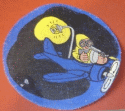 NS0206az |
57k | On 1 January 1944 a detachment of VF(N)-75 under LCDR Richard "Chick" Harmer became VF(N)-101, split between USS Enterprise (CV-6) and USS Intrepid (CV-11). They flew F4U-2 Corsairs—if it was a hard enough job to operate F4Us off carriers in daylight, it was even harder at night. Intrepid was torpedoed in February and VF(N)-101 Det. 11, under LT Cecil "Swede" Kullberg, went ashore. The detachment aboard Enterprise claimed five confirmed kills (two by Harmer and three by LT(JG) Robert F. Holden) between January and June 1944. VF(N)-101 disembarked in July, and was disestablished on 2 October 1944. |
Tommy Trampp | |
| Marshall Islands and Truk, February 1944 |
||||
 NS020684 |
481k | Official US Navy photograph of USS Enterprise (CV-6), 22 January 1944, en route to attack the Japanese airbase at Taroa Island, Maloelap Atoll, Marshall Islands. |
Robert M. Cieri | |
 NS020684a |
127k | Photo NS020684 was also published with this caption: "U.S.S. ENTERPRISE |
Tommy Trampp | |
 NS020618 |
434k | Apparently taken at about the same time as photo above. Photographer unknown. |
John N. Egeland, Jr. | |
 NS020646 |
90k | Good shot of the island and Enterprise's new F6F-3's on the flight deck ready for strikes against the Marshall Islands, February 3rd, 1944. |
Steve Whitby | |
 NS020625 |
91k | Grumman F6F-3 "Hellcat" fighters landing on USS Enterprise (CV-6) after strikes on the Japanese base at Truk, 17-18 February 1944. Flight deck crewmen are folding planes' wings and guiding them forward to the parking area. The original caption gives date as 16 February. Official U.S. Navy Photograph, now in the collections of the U.S. National Archives (photo # 80-G-59314). |
Scott Dyben | |
| Landings on Emirau Island, March 1944 |
||||
 NS0206ae |
349k | USS Enterprise (CV-6) underway in the Central Pacific area, March 1944. Note SBD-5 Dauntless aircraft from Bombing Squadron (VB) 10 parked forward, including one with its tail supported on an outrigger just in front of the island. National Archives and Records Administration (NARA) photo, # 80-G-251013. |
Courtesy of Brian James, via Gordon Buttars |
|
 NS020604 |
101k | As part of Task Force 36.1, the ship is seen from one of her just launched planes as she was in the process of launching an air strike against Emirau in the Bismarck Archipelago, 20 March 1944. | USN | |
 NS020605 |
107k | Another shot of the ship on her way to provide air cover and close support to the Emirau Island raid. This photo was taken by one of her own planes as it sped by the carrier, yet the focus is perfect; 20 March 1944. | USN | |
 NS020667 |
50k | The "Big E" had her island modified during her July-October 1943 refit. Note new platforms on both the navigation and flag bridges, for better visibility, and Mk.37 dual purpose director (with Mk.4 radar antenna) in place of her former Mk.33. Photo taken on March 20, 1944 from one of her own planes. |
Steve Whitby | |
 NS020686 |
86k | USN photo of USS Enterprise (CV-6) underway at high speed while engaged in raids against Palau during March-April of 1944. She is painted in Measure 21 and her radar equipment consists of SK, SC-2 and SM sets. |
Robert Hurst | |
| Mid-1944 |
||||
NS020600 |
88k | A Douglas SBD-5 Dauntless of VB-10 rolls along the flight deck of USS Enterprise (CV-6) into the sun, spring 1944. USN photo. From "Carrier Air War in Original WWII Color," by Robert Lawson and Barrett Tillman. |
Robert Hurst | |
 NS020626 |
115k | TBM Avenger torpedo bombers warming up on the after flight deck during operations in the Pacific, circa May 1944. An F6F Hellcat fighter is on the midships elevator, in the foreground. The original Kodachrome color transparency was received by the Naval Photographic Science Laboratory on 29 May 1944. Official U.S. Navy Photograph, now in the collections of the U.S. National Archives (photo # 80-G-K-1590). |
Scott Dyben | |
 NS020687 |
117k | Two Air Group Ten SBD Dauntlesses overfly USS Enterprise (CV-6), probably in June 1944. |
Robert Hurst | |
 NS0206ah |
80k | S1/c Clemens S Wittlieff served aboard USS Enterprise (CV-6), L Division, June 1944–June 1946. His 20mm gun was on the starboard side along the superstructure, 3rd gun in. He always said that his placement was where the crane was located prior to the 1943 refit. |
Mark M Wittlief, son of Clemens S Wittlieff | |
 NS0206cl |
238k | USS Enterprise (CV-6) underway in the Central Pacific, June 1944. USS Lexington (CV-16) is in the background. National Naval Aviation Museum, photo # 1996.272.019. |
Mike Green | |
 NS0206bk |
626k | USS Enterprise (CV-6) as seen from a Douglas SBD Dauntless aircraft that has just launched. USS Lexington (CV-16) steams along in the background, July 1944. National Archives and Records Administration (NARA), photo # 80-G-281800. |
NARA | |
 NS020602 |
129k | The Big E shows her late-war appearance and new dazzle camouflage (Measure 33/4Ab) in these 2 August 1944 photos, taken as she departed Pearl Harbor. According to Ms. 33 specifications, colors should be pale gray, haze gray and navy blue but, judging from existing photographs, it seems possible that, in fact, dull black or blue/black were substituted for navy blue. On photo NS1201125101 note PC-1251 is passing Enterprise on the port side. The PC, which had arrived in Pearl Harbor just a few weeks earlier, is painted in a dark color but her mast, painted in light gray above the top of the stack, is reminiscent of Measure 1, which had been officially discontinued in September 1941 (!). (Photo from U.S. Aircraft Carriers: An Illustrated Design History, by Norman Friedman.) (Thanks to Robert Hurst, who provided additional info). NS020602c: National Archives and Records Administration (NARA) photo, Local Identifier 19-LCM-CV6-71792. NS020602d: National Naval Aviation Museum photo # 1996.488.272.023. |
USN | |
 NS020602a |
185k | National Archives photo # NA-19-N-71787. Submitted by Robert M. Cieri |
||
 NS020658 |
155k | Steve Whitby | ||
 NS020659 |
115k | Steve Whitby | ||
NS1201125101 |
274k | Robert Hurst | ||
 NS020602b |
185k | David Buell | ||
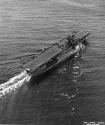 NS020602c |
697k | NARA | ||
 NS020602d |
615k | Mike Green | ||
 NS020688 |
119k | USS Enterprise (CV-6) departs Pearl Harbor, mid-August 1944, with her newly applied dazzle camouflage and new Air Group 20 aboard. |
Robert Hurst | |
 NS020640 |
94k | Anchored off Saipan, circa mid-1944, while painted in camouflage Measure 33, Design 4Ab. The photograph was taken from the flight deck of an escort carrier (CVE). Courtesy of Don S. Montgomery, USN (Retired). U.S. Naval Historical Center photograph (# NH 97266). |
NHC | |
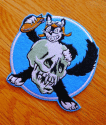 NS020660 |
115k | Bombing Squadron Twenty (VB-20) insignia. The squadron was established as VB-99 on 1 July 1943, redesignated VB-20 on 15 October 1943, VA-9A on 15 November 1946, and VA-94 on 12 August 1948. It was disestablished on 30 November 1949. Nicknamed "Bombing Twenty's Tough Kitty" in 1943–1946, it was aboard USS Enterprise (CV-6) between 16 August and 23 November 1944; flying SB2C-3 Helldivers, and as part of Air Group 20, it participated in the Bonin Islands raid, the Palau occupation, Nansei Shoto and Formosa raids, Leyte landings, Battle of Leyte Gulf, and the Philippine Islands raids. |
Tommy Trampp | |
| 1945 |
||||
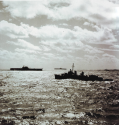 NS0206ci |
509k | Third Fleet warships en route to the Philippines, circa January 1945. USS Stephen Potter (DD-538) is in the right center, closest to the camera. Aircraft carrier at left is USS Enterprise (CV-6). Photographed from USS New Jersey (BB-62) by Lieutenant Commander Charles Fenno Jacobs, USNR. Official U.S. Navy Photograph, now in the collections of the National Archives and Records Administration, # 80-G-470275. |
Robert Hurst | |
 NS020641 |
87k | Landing Signal Officer, Ensign R. J. Grant, guides in an F6F "Hellcat" fighter, during flight operations on 13 March 1945. Taken by Photographer's Mate 3rd Class W.T. Stillman. Official U.S. Navy Photograph, now in the collections of the National Archives (photo # 80-G-319008). |
NHC | |
 NS020668 |
69k | Damaged TBM Avenger, March 1945. The outlined arrow on the tail ("G" symbol) was not the design assigned by the Bureau of Aeronautics, but the ship's CO, CAPT Hall, believed it reduced aircraft visibility during night operations, at a time when his ship was operating as a night carrier. |
Steve Whitby | |
| Okinawa, April-May 1945 |
 NS0409518 |
83k | USS Enterprise (CV-6), at left, under attack by a Japanese suicide plane, during operations off Okinawa on 11 April 1945. She was hit and damaged on this day, but returned to action in early May following repairs made at Ulithi. At right is USS Oakland (CL-95), which is opening fire on the diving plane. Note tracer shells streaking across the upper part of the image. Official U.S. Navy Photograph, now in the collections of the National Archives (photo # 80-G-315762). |
Tom Bateman |
| Kamikaze attack, May 1945 |
||||
 NS020608 |
69k | This photo taken on 14 May 1945, from USS Washington (BB-56), shows USS Enterprise (CV-6) exploding from a bomb-laden kamikaze. The ship's forward elevator was blown approximately 700 feet into the air from the force of the explosion, six decks below. | USN | |
 NS020608a |
100k | Parts of Enterprise's elevator may be seen after being blown high over the carrier after she was hit by a Zeke with a 551-pound bomb on 14 May 1945. This photograph was taken from Bataan (CVL-29). USS Enterprise CV 6 Serial 0273. Action Report of USS Enterprise (CV6) in Connection with Operations in Support of Amphibious Landings at Okinawa 3 May to 16 May 1945—Phase III. 22 May 1945, p. 28. |
Gerd Matthes, Germany | |
 NS020609 |
89k | Kamikaze attack, 14 May 1945. This shows the elevator pit after the elevator was blown out and fires were being extinguished. |
Robert Rocker | |
 NS020612 |
56k | Another view of the Enterprise being struck by a kamikaze on May 14, 1945. While a bit grainy, the extent of the explosion is still evident. | USN | |
 NS020612a |
148k | Crew fights fires after the Kamikaze crash, 14 May 1945. |
Gerd Matthes, Germany | |
 NS020612b |
83k | Caption reads: "This picture was taken from USS Essex (CV-9), at USS Enterprise (CV-6) as a Japanese bomb blew her forward elevator sky high." A comment added: "Enterprise was saved because the side hangar doors were open and vented much of the blast out the sides of the ship." | Brian Skon, via Gordon Buttars |
|
 NS020647 |
111k | Bulged flight deck from a Kamikaze strike on the forward elevator, blowing it 400' in the air. This finished CV-6's combat career. She was sent back to Puget Sound for major repairs. |
Steve Whitby | |
 NS020664 |
67k | USS Enterprise (CV-6) transferring casualties to USS Bountiful (AH-9) on 15 May 1945, a day after the carrier had been hit by a kamikaze in the vicinity of the forward elevator. Collection of Admiral Arleigh A. Burke, donated in 1973–75. Naval History & Heritage Command photograph, # NH 99384-A, cropped from photo # NH 99384. |
NHC | |
 NS020664a |
64k | USS Enterprise (CV-6) transferring casualties to USS Bountiful (AH-9) on 15 May 1945, a day after the carrier had been hit by a kamikaze in the vicinity of the forward elevator. Collection of Admiral Arleigh A. Burke, donated in 1973–75. Naval History & Heritage Command, photo # NH 99384 (see also NS020664). |
Gerd Matthes, Germany | |
 NS0206ak |
195k | USS Enterprise (CV-6) anchored off Puget Sound Navy Yard in June 1945, preparing for dry docking and repairs from kamikaze damage occurring on May 14th. The ship appears to be off loading ammunition at the stern, while crew members are boarding the ferry City of Sacramento at the bow. The forward elevator is conspicuous in its absence, as it was destroyed in the May 14th attack. Courtesy of the US Navy and Marine Corps Museum/Naval Aviation Museum, Photo No.1996.488.272.027. |
Mike Green | |
 NS0206cg |
260k | This appears to be USS Enterprise (CV-6) being repaired after the 14 May 1945 Kamikaze attack. |
John Chiquoine and Dave Schroeder | |
 NS021353a .PDF file Get FREE Adobe Reader |
68k | "Story of Phil and Hal Smith, two brothers aboard USS Enterprise and USS Franklin," by Dixie Smith. |
Brenda Mullen, daughter of Dixie Smith, niece of Phil and J. Harold "Hal" Smith | |
 NS020697 |
60k | V-J announcement. |
Tracy White, Researcher @ Large | |
 NS020697a |
69k | |||
 NS020697b |
52k | |||
 NS0206bv |
674k | "Saving a U.S. Carrier—Crewmen slipping and wallowing in foam used to quench the March 20 fire aboard the USS Enterprise caused by an anti-aircraft shell from another U.S. ship. The Enterprise crew had just finished shooting down four Jap planes. Within two weeks she was back in action. International Photo"
Detroit Times, 28 August 1945, page C-13. |
Library of Congress, Chronicling America, via Michael Mohl | |
| Post-War |
||||
 NS020665 |
103k | "Aircraft Carrier Enterprise." (From a Russian publication). Basically, this drawing shows the "Big E" after her 1945 refit, at the very end of the war. However, 40-mm gun mounts forward of the forward pairs of 5" guns were actually two quads and two twins (see below, 020627). Also, the 20-mm battery shown is too large, and is actually closer to that fitted during the ship's July-October 1943 refit. |
Alex Tatchin | |
 NS020665a |
111k | Deck plan and side elevation depicting USS Enterprise (CV-6) as she appeared at the end of the war, in September 1945, but the drawings show the wrong number of 20 mm and 40 mm AA guns. Recent research indicates the exact number and position of AA guns, which has been marked by arrows in the plan view. The final radar equipment of this ship included SK and SP (on the mast platform), and SC-2 (on the stack). |
Robert Hurst | |
 NS020631 |
112k | USS Enterprise (CV-6) making 20 knots during post-overhaul trials in Puget Sound, Washington, 13 September 1945. Photograph from the Bureau of Ships Collection in the U.S. National Archives (photo # 19-N-89185). |
NHC | |
 NS020631c |
265k | USS Enterprise (CV-6) making 20 knots, in Puget Sound, Washington, 13 September 1945. National Archives & Records Administration (NARA) photo, # 19-N-89186. |
David Buell | |
 NS020631d |
161k | USS Enterprise (CV-6) making 20 knots, in Puget Sound, Washington, 13 September 1945. National Archives & Records Administration (NARA) photo, # 19-N-89187. |
David Buell | |
 NS020631b |
159k | USS Enterprise (CV-6) making 20 knots, in Puget Sound, Washington, 13 September 1945. National Archives & Records Administration (NARA) photo, # 19-N-89188. |
Mike Green | |
 NS020631a |
81k | USS Enterprise, painted in Measure 21, cruising off Puget Sound, 13 September 1945. Two 40mm quad mounts are installed in the positions where the outriggers for the hangar catapults had formerly been fitted, and two forward twins (port and starboard) have been replaced by quads (USN photo). |
Robert Hurst | |
 NS020632 |
116k | Naval Air Station, Alameda, California — Four aircraft carriers docked at the Air Station's piers, circa mid-September 1945. The ships are (from front to back): USS Saratoga (CV-3), USS Enterprise (CV-6), USS Hornet (CV-12) and USS San Jacinto (CVL-30). Note PBY amphibians parked at the far left. Official U.S. Navy Photograph, now in the collections of the National Archives (photo # 80-G-701512). Note that four, out of five, classes of fast Aircraft Carriers that fought in the Pacific (only the one-ship class Wasp is missing) are represented in this photograph. |
NHC | |
 NS0206bp |
62k | A "photo of the USS Enterprise (CV-6), taken on 24 September 1945, while she was tied up at Ford Island, Pearl Harbor. The photo was taken by one of her photo-mates—William T. Barr, and the Sailor in the foreground, is another Sailor, and fellow photo-mate of his, Robert Anderson." |
Bob Haner, YN1, USN (Ret.) | |
NS020685 |
42k | Gordon G. Buttars comments: "My father, an Enterprise veteran had a large framed 16 x 20 copy of this photo hanging in his home. [...] Behind the picture was a note that must have come with the photograph stating [... it was] taken in [late] September 1945 enroute to the Panama Canal." Although details in this copy of the photo are not clear enough, it appears that a twin Bofors gun is absent from Big E's bow. It had been installed in 1943 and was removed during her last refit, June–September 1945, as weight compensation for guns added elsewhere. This agrees with Gordon's comment. |
Robert Hurst | |
 NS020614 |
166k | Overhead view of the ship in her final days in the Pacific Ocean as she heads for the Panama Canal. | USN | |
 NS020615 |
89k | USS Enterprise (CV-6) en route to New York to take part in the Navy Day Fleet Review, October 1945. She is steaming in company with a light carrier (CVL) —in the right distance— and another warship. Official U.S. Navy Photograph, now in the collections of the National Archives (photo # 80-G-K-6576). |
Scott Dyben | |
 NS0206at |
44k | USS Enterprise (CV-6) passing through the Panama Canal, (apparently) in October 1945 |
Courtesy of the Panama Historical Society, via Ron Armstrong | |
 NS020627 |
133k | USS Enterprise (CV-6) steams toward the Panama Canal on 10 October 1945, while en route to New York to participate in Navy Day celebrations. Official U.S. Navy Photograph, now in the collections of the U.S. National Archives (photo # 80-G-701166). |
Scott Dyben | |
 NS0206be |
286k | Bow view of USS Washington (BB-56) and USS Enterprise (CV-6) transiting the Panama Canal Miraflores Locks from the Pacific to the Atlantic, 12 October 1945. Life Magazine Archives, Thomas Mcavoy photographer. Used for non-commercial, educational purposes. |
Mike Green | |
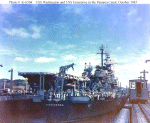 NS015628 |
116k | USS Washington (BB-56) and USS Enterprise (CV-6) transiting the Panama Canal from the Pacific to the Atlantic, early in October 1945. They were then en route to New York to participate in Navy Day celebrations. Official U.S. Navy photo, now in the collections of the National Archives and Records Administration (NARA), photo # 80-G-K-6568. |
NARA | |
 NS0206bea |
636k | Aerial view of USS Enterprise (CV-6) underway, 12 October 1945. The ship was heading for New York City Navy Days Celebrations to be held on 25th October. National Naval Aviation Museum, photo # 1996.488.272.028. |
Mike Green | |
 NS020671 |
86k | Moored to Pier 26 North (Hudson) River, New York, second half of October 1945. |
Photo probably taken by Anita Russell. Submitted by her daughter, Amy Cohen | |
 NS020683a |
104k | An outstanding photo of USS Enterprise (CV-6) as she makes her way up the lower Hudson River on the early morning of 17 October 1945, on her way to an anchorage for the 27 October Navy Day Victory celebration. This is an AP Wirephoto. Somewhat grainy, but that adds to the dramatic look of this photo, with the city of New York silhouetted in the background. |
David Buell | |
 NS020683f |
68k | USS Enterprise (CV-6) is seen on 17 October 1945, being assisted by tugs to her appointed mooring spot in the Hudson River for the upcoming Navy Day Celebration. United States National Archives, photo # 80-G-K-6557. |
Mike Green | |
 NS020683 |
108k | Photo taken on or about 27 October 1945 in the Hudson River, during Navy Day celebrations. |
David Buell | |
 NS020683b |
75k | USS Enterprise (CV-6) anchored in the Hudson River, off New York City, at the time of the Navy Day Fleet Review, circa late October 1945. Collection of Warren Beltramini, donated by Beryl Beltramini, 2007. U.S. Naval Historical Center Photograph (# NH 105563). |
NHC (thanks to Chuck Haberlein) | |
 NS020683c |
62k | USS Enterprise (CV-6), off New York City, 27 October 1945. |
Gary Schreffler | |
 NS020683d |
83k | |||
 NS020683g |
338k | As above. |
Charles Roberts, Roberts Armory World War II Museum | |
 NS020683e |
4.74Mb | Family film, 16mm color footage of Navy Day 1945, taken from Riverside Drive in New York City. The film was probably shot by Thomas A. Woolsey, Kris's grandfather. Format: M4V (.m4v) Duration: 41" Size: 480 x 272 |
Kris Woolsey | |
 NS0206bb |
165k | USS Enterprise (CV-6) during Operation Magic Carpet. |
David Buell | |
 NS0206ag |
102k | "(NY15--Nov.26)--'BIG E' LOADED WITH TROOPS BOUND FOR U.S.A.--The famed U.S. carrier Enterprise, the rails of her flight deck jammed with returning servicemen, prepares to put out from Southampton, England, Nov. 23, bound for New York City, N.Y., where she is due Nov. 29. The veteran Pacific flattop is making her first Atlantic crossing since conversion as a troop-carrier. (AP wirephoto)(wb21600lon.) 1945" |
David Buell | |
 NS0206bu |
98k | "USS Enterprise (CV-6) at Southampton, England, during Operation Magic Carpet, preparing for one of her last voyages." "Tying up briefly in Southampton, on her November Magic Carpet voyage, Enterprise became the first—and to date only ship outside the Royal Navy—ever awarded that Navy's highest honour: the 'Admiralty Pennant'." "On that voyage, she carried 4668 servicemen home from Europe; on her next voyage, she carried another 4413 military passengers from Southampton, arriving in New York on Christmas Eve 1945. Her last Magic Carpet voyage took her to the Azores, where she picked up 3557 passengers, including 212 WACS, returning to New York 17 January 1946. The next day she moored at Bayonne, New Jersey: a proud ship, but never to sail under her own power again." |
Brian James, via Gordon Buttars | |
 NS0206bua |
96k | |||
 NS0206bub |
103k | |||
 NS020613 |
108k | Shown here leaving Southampton, England on December 17, 1945. | USN | |
| In "Mothballs" |
||||
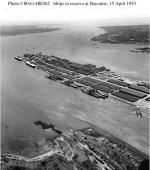 NS015535 |
112k | Bayonne Naval Supply Depot, New Jersey. Photographed on 15 April 1953 with ships in reserve. The two large ships at right on the near side of the peninsula are Alaska (CB-1) and Guam (CB-2). The next two ships astern are North Carolina (BB-55) and Washington (BB-56). Further astern are (from outboard to inboard) Fargo (CL-106), Albemarle (AV-5) and Wakefield (AP-21). The carriers Enterprise (CVA-6) and Franklin (CVA-13) are at the far left. Also present are the escort carriers Card (CVE-11), Croatan (CVE-25), Mission Bay (CVE-59) and Guadalcanal (CVE-60) along with the cruisers Providence (CL-82), Little Rock (CL-92), Spokane (CLAA-120) and Fresno (CLAA-121). One of the two CLAAs is tied up outboard of the Alaskas. National Archives and Records Administration (NARA) photo, # 80-G-480262. |
Via Robert Hurst | |
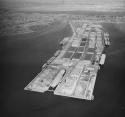 NS0206bz |
126k | Aerial view of the U.S. Navy Bayonne Naval Supply Depot, New Jersey, on 24 July 1953. The aircraft carrier ex-USS Enterprise (CVA-6) is in the drydock in the foreground. National Archives and Records Administration (NARA) photo, # 80-G-625322. |
Robert Hurst | |
|
||||
| Main Photo Index |
Aircraft Carrier Photo Index Page |
Comments, Suggestions or Image submissions, E-mail Carrier Information
Problems and site related matters, E-mail Webmaster
This page was created and is maintained by Fabio Peña
![]()
Last update: 5 February 2025